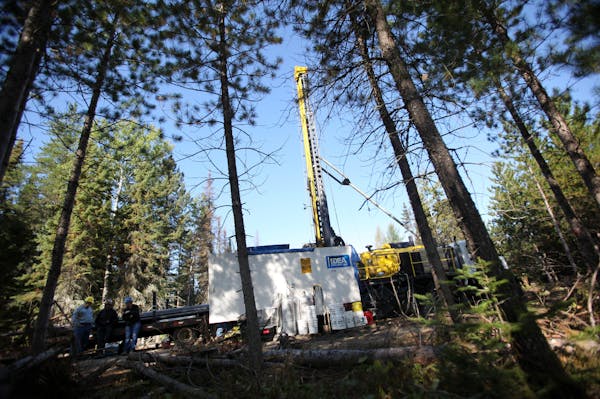Twin Metals announced Thursday that if its fiercely contested copper-nickel mining project is approved, it will build a 100-acre ore-processing facility on the banks of Birch Lake and closer to the Boundary Waters Canoe Area Wilderness than originally planned.
The change drew immediate criticism from environmentalists, who said that the new location for the ore processing facility, the heart of the mine operation, will increase the threat to pristine waters of the wilderness, because any polluted runoff from the site would be much closer.
"It's made a bad plan even worse," said Becky Rom, head of Save the Boundary Waters, one of the environmental nonprofits fighting the project.
Officials from the company, a subsidiary of the Chilean mining giant Antofagasta, said that regardless of the location, the facility has to meet environmental standards set by state and federal regulators.
"This will not pose a risk to the environment," said Bob McFarlin, Twin Metals' vice president of environmental affairs.
The company also said it plans to build a new office in Babbitt and to put a mine waste storage facility close to the Peter Mitchell taconite mine, which is outside the watershed that includes Birch Lake and the Boundary Waters.
McFarlin said that the plans are preliminary and could still change. Its final mine plan is expected to be complete by next summer. Environmental review will take place after that.
Twin Metals' project would be the second copper-nickel mine in the state, following PolyMet Mining's $1 billion open-pit mine farther south, near Hoyt Lakes. That project is awaiting final regulatory approval.
Both are highly controversial, because copper mining carries greater environmental risks than the iron and taconite mining that have long been part of the state's history. The metals are contained in sulfide-bearing ore, which creates an acid when exposed to air and water that can leach heavy metals and other contaminants out of rock.
Mining officials say that both projects will adhere to regulatory standards, and the prospect of a new kind of mining and hundreds of new jobs is reviving hopes in the economically depressed Iron Range.
Unlike PolyMet's, however, Twin Metals' underground mine would be on the doorstep of the BWCA, in the water-rich environment alongside the Kawishiwi River and Birch Lake, which flow into the wilderness area.
Late last year, the Trump administration dashed the hopes of environmentalists when it reversed an earlier decision by the Department of the Interior that had denied mineral leases to Twin Metals and essentially suspended the project.
The administration also scaled back a major environmental review launched by the U.S. Forest Service to determine whether mining is an appropriate activity for federal lands around the BWCA. That review is ongoing.
Tunnels and tailings
On Thursday, Twin Metals provided new details of what the mine would look like if it's constructed.
Initially, the processing facility, where precious minerals would be separated from ore, was to be built on the west side of Birch Lake, south of the Ely airport. The facility would process 20,000 tons of ore a day, pulling out metal concentrates that make up about 1 percent of the rock.
The company had planned to build tunnels through bedrock under the lake to move ore out of the underground mine to the processing facility. Now, McFarlin said, the new site a mile south of the mine would require much shorter tunnels and create a smaller overall footprint.
Eventually, waste rock and half the tailings would be moved back into the underground mine for permanent storage, McFarlin said. The other half of the tailings would be moved to the long-term storage site near Babbitt.
Rom, however, said that waste rock stored on the surface next to the lake poses a greater risk to the Boundary Waters. Bedrock in the area is right on the surface, meaning any runoff from the site would flow immediately into the lake, river and surrounding wetlands.
Her organization has commissioned peer-reviewed studies showing that the area's delicate ecosystem is especially vulnerable to acid runoff.
Josephine Marcotty • 612-673-7394

Want to share info with the Star Tribune? How to do it securely

'Safe recovery sites' would offer syringes, naloxone and more to people using drugs. The plan could be in peril.
New Minnesota GOP leaders seek peace with party's anti-establishment wing

Who is Republican Lisa Demuth, Minnesota's first House speaker of color?

